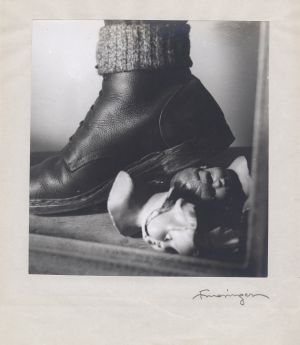MUO-024631: Užas: fotografija
Inventarna oznaka
MUO-024631
Naziv zbirke
Autor (osoba)
Književni naziv
Naslov predmeta
Užas
Država nastanka
Grad nastanka
Godina nastanka
1933.
Stoljeće nastanka
20. – . st.
Materijal izrade
Tehnika izrade
Dimenzije (v1xš1xd1)
16.4 × 15.3 cm
Opis predmeta
Fotografija naslovljena Užas nastaje u vrijeme Hitlerova dolaska na vlast 1933. godine. Muška cipela koja gazi krhke porculanske glave bjelopute i tamnopute lutke jedna je od najčešće reproduciranih Mosingerovih fotografija.
Franjo Mosinger (Zagreb, 1899. – 1956.) nakon završene Höhere Graphische Bundes- Lehr- und Versuchsanstalt započinje studij arhitekture u Beču. Godine 1918. nakon smrti svog oca Rudolfa prekida studij i vraća se u Zagreb, te preuzima renomirani očev atelijer u Ilici 8. Izložba Franje Mosingera u Umjetničkom paviljonu 1931. godine manifestno je nazvana Novi smjer u fotografiji. Izlaže niz “čistih” fotografija s već prisutnim impulsima poetike i karakterističnog repertoara Nove objektivnosti. Uočavanje efemernog motiva u fotografskom je predočavanju analogno upotrebi ready-made predmeta Marcela Duchampa. Mosinger je prvi u Hrvatskoj, nedugo nakon Mana Raya, izložio fotograme, fotografije nastale bez negativa, neposrednim osvjetljavanjem predmeta pred fotopapirom. Sljedeća izložba Lice grada predstavlja razdjelnicu i definitivan prekid sa starim načinom promišljanja te unosi novi pristup i estetiku.
Mosinger je udario temelje modernoj fotografiji u Hrvatskoj i zaslužan je za njeno prihvaćanje kao ravnopravne umjetničke discipline u razdoblju ranih tridesetih godina.
Ključne riječi
MUO baza
Autorska prava / Prava korištenja
